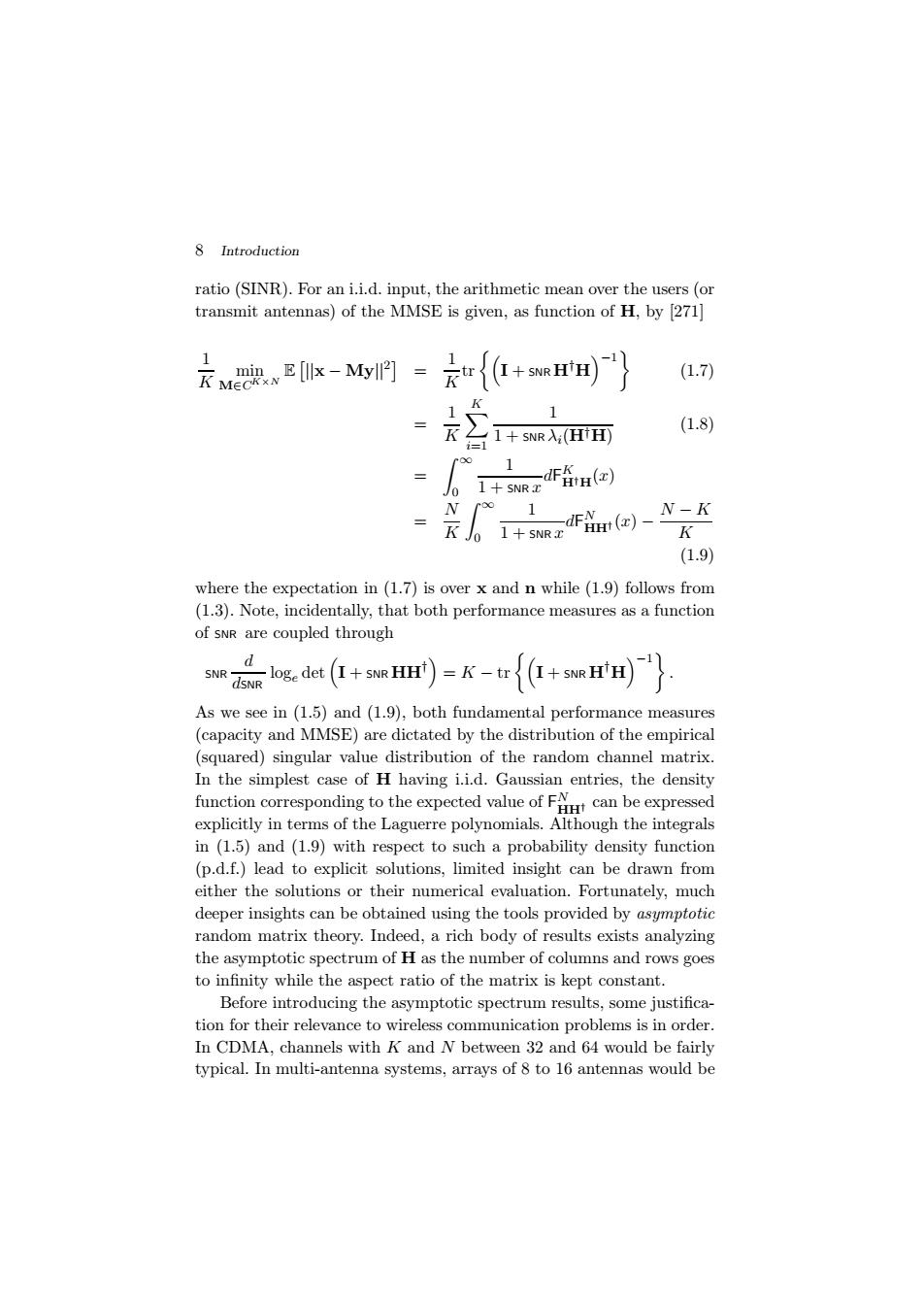正在加载图片...

8 Introduction ratio(SINR).For an i.i.d.input,the arithmetic mean over the users(or transmit antennas)of the MMSE is given,as function of H,by [271] (1.7) K 1 台I+SNR(H可 (1.8) 0 1+SNRT dF(z) N oo 1 dt()- N-K K Jo 1+SNR K (1.9) where the expectation in(1.7)is over x and n while(1.9)follows from (1.3).Note,incidentally,that both performance measures as a function of sNR are coupled through d SNR- og et(+sHIr)=K-{在+H)} As we see in (1.5)and (1.9),both fundamental performance measures (capacity and MMSE)are dictated by the distribution of the empirical (squared)singular value distribution of the random channel matrix. In the simplest case of H having i.i.d.Gaussian entries,the density function corresponding to the expected value of Fcan be expressed explicitly in terms of the Laguerre polynomials.Although the integrals in (1.5)and (1.9)with respect to such a probability density function (p.d.f.)lead to explicit solutions,limited insight can be drawn from either the solutions or their numerical evaluation.Fortunately,much deeper insights can be obtained using the tools provided by asymptotic random matrix theory.Indeed,a rich body of results exists analyzing the asymptotic spectrum of H as the number of columns and rows goes to infinity while the aspect ratio of the matrix is kept constant. Before introducing the asymptotic spectrum results,some justifica- tion for their relevance to wireless communication problems is in order. In CDMA,channels with K and N between 32 and 64 would be fairly typical.In multi-antenna systems,arrays of 8 to 16 antennas would be8 Introduction ratio (SINR). For an i.i.d. input, the arithmetic mean over the users (or transmit antennas) of the MMSE is given, as function of H, by [271] 1 K min M∈CK×N E ||x − My||2 = 1 K tr I + SNR H† H −1 (1.7) = 1 K K i=1 1 1 + SNR λi(H†H) (1.8) = ∞ 0 1 1 + SNR x dFK H†H(x) = N K ∞ 0 1 1 + SNR x dFN HH† (x) − N − K K (1.9) where the expectation in (1.7) is over x and n while (1.9) follows from (1.3). Note, incidentally, that both performance measures as a function of SNR are coupled through SNR d dSNR loge det I + SNR HH† = K − tr I + SNR H† H −1 . As we see in (1.5) and (1.9), both fundamental performance measures (capacity and MMSE) are dictated by the distribution of the empirical (squared) singular value distribution of the random channel matrix. In the simplest case of H having i.i.d. Gaussian entries, the density function corresponding to the expected value of FN HH† can be expressed explicitly in terms of the Laguerre polynomials. Although the integrals in (1.5) and (1.9) with respect to such a probability density function (p.d.f.) lead to explicit solutions, limited insight can be drawn from either the solutions or their numerical evaluation. Fortunately, much deeper insights can be obtained using the tools provided by asymptotic random matrix theory. Indeed, a rich body of results exists analyzing the asymptotic spectrum of H as the number of columns and rows goes to infinity while the aspect ratio of the matrix is kept constant. Before introducing the asymptotic spectrum results, some justification for their relevance to wireless communication problems is in order. In CDMA, channels with K and N between 32 and 64 would be fairly typical. In multi-antenna systems, arrays of 8 to 16 antennas would be������